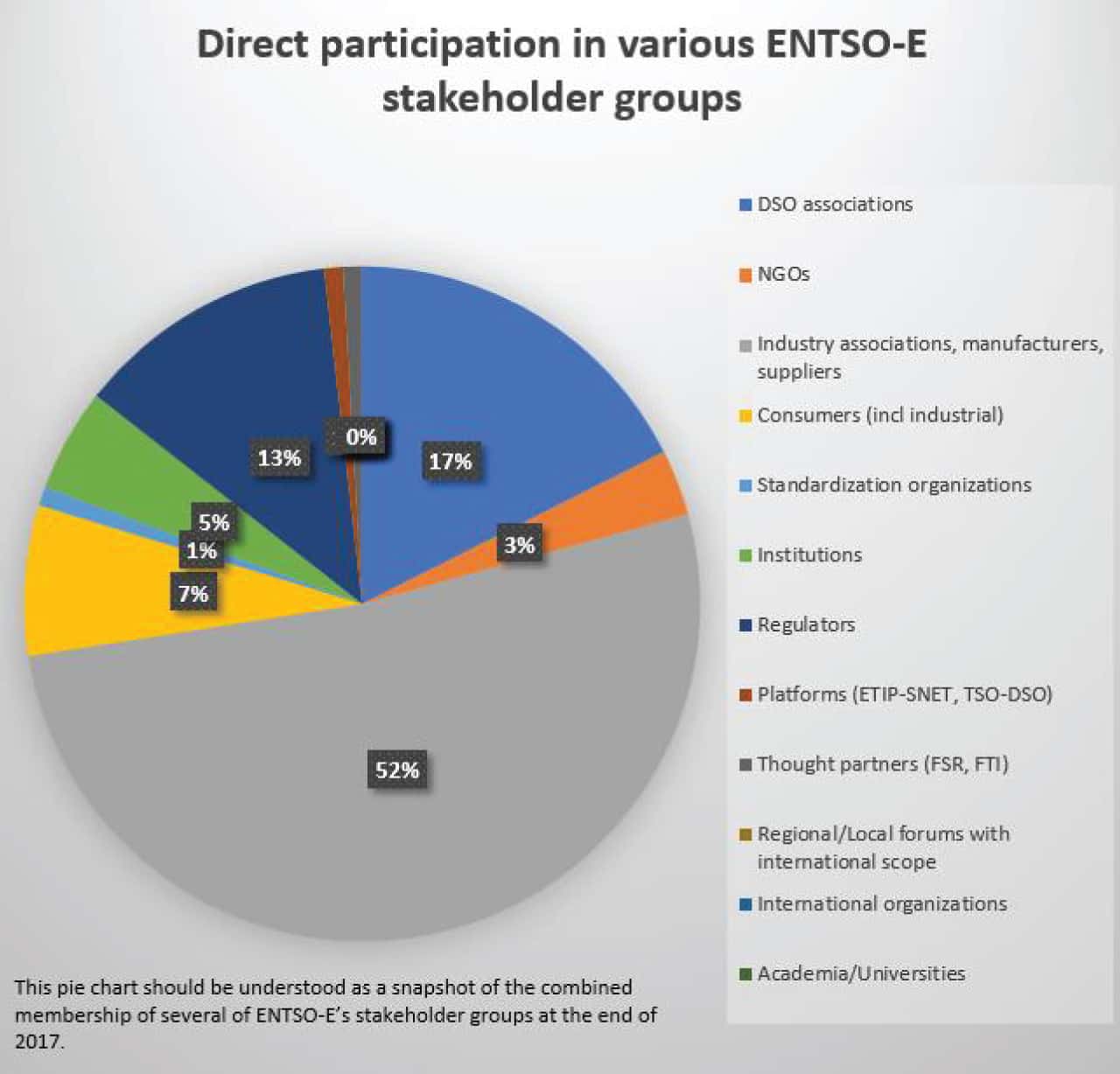Looking back at stakeholder engagement in 2017
ENTSO-E engages with stakeholders via a number of dedicated groups, public consultations, its annual conference, its workshops and other events, training and individual contacts. Overall stakeholder satisfaction with ENTSO-E’s work has increased by 3.6% in 2017 compared to 201617.
Stakeholders’ feedback is generally positive regarding stakeholders groups, who are seen as providing adequate fora for discussion. These include for example the Advisory Council, the three Network Codes European Stakeholder Committees, the Balancing Stakeholders Group, the Network Development Stakeholder Group and the Transparency Platform Users Group. Involved stakeholders represent a wide range of interests across the electricity sector. However, ENTSO-E has noted an under-engagement of NGOs, RES and consumer representatives, likely due to limited staff resources. This discrepancy tends to be more important regarding highly technical topics. To restore the balance, ENTSO-E engages in individual contacts on an ad-hoc basis.
ENTSO-E’s independent Advisory Council, which met four times in 2017, has provided advice to ENTSO-E’s Board on ENTSO-E’s general strategy and on our main work products (such as our Annual Work Program 2018 and policy papers), TSO-DSO cooperation, network code development, and the role of TSOs regarding storage (its minutes and recommendations to ENTSO-E are available here). ENTSO-E’s Board has approved the proposed extension of the Council’s membership to increase the representation of NGOs and RES associations, and the invitation of additional stakeholders. A final decision is expected to be taken by ENTSO-E’s Assembly at the end of June 2018.
Our Stakeholder survey shows mixed results regarding our public consultation process, with stakeholders highlighting a number of shortcomings regarding the length, timing and foreseeability of consultations. ENTSO-E’s Consultation rules of procedure specify that ENTSO-E should strive for a two-months consultation period, and that the minimum length should be one month. Over the 54 online consultations launched in 2017, the majority (45) ran for 4 to 6 weeks. One was shorter than 4 weeks. Additionally, stakeholders report difficulties meeting consultation deadlines set during the summer holidays. Three consultations running for 4 and 5 weeks largely over August 2017 did not allow for proper engagement.
17 According to the results of our Stakeholder Survey 2017, conducted in January 2018.
As required by Regulation 714/2009 (Article 5(1)), ENTSO-E’s public consultations follow a number of rules set in our Consultations Rules of procedure, approved in 2011 and submitted to ACER (these rules are currently being reviewed). The Regulation (Article 10) further specifies that ENTSO-E must conduct „an extensive consultation process, at an early stage and in an open and transparent manner, involving all relevant market participants“. Consultation are required by the Regulation on the network codes, on our annual work programme and on the TYNDP. In addition, the network codes themselves specify that a number of implementation deliverables must be consulted upon.
Public consultations were announced in advance in our annual work programme for 2017 published end 2016, with a rather good level of accuracy overall. However, the consultations announced in the AWP did not include those organised under the responsibility of Capacity Calculation Regions as part of the CACM implementation, which represented just under one-third of all consultations ran in 201718.
To provide better information on upcoming consultations part of network code implementation in future, ENTSO-E is keeping up-to-date a planning of upcoming activities, including consultations and workshops, for each code on the new website electricity.network-codes.eu. ENTSO-E is also in the process of reviewing its consultation rules, with a view to making it easier for stakeholders to answer.
2017 saw the introduction of innovative engagement practices. The network codes Issue Logger tool centralises stakeholders’ queries on network code implementation, including answers provided by the EC, ACER or TSOs. In addition, ENTSO-E co-developed with the Florence School of Regulation training on network codes, to which a diverse range of stakeholders participated in September-October 2017. Both initiatives received positive feedback.
18 17 CCRs consultations on fallback procedures and capacity calculation methodologies

